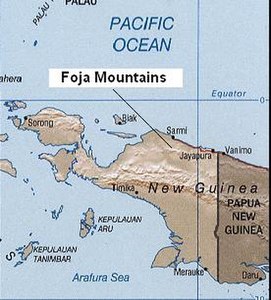Foja Mountains
| Fojaegebirge | |
|---|---|
|
Foja Mountains in New Guinea |
|
| location | Indonesia |
| part of | New Guinea |
| Coordinates | 2 ° 22 ′ S , 139 ° 3 ′ E |
| surface | 9,712 km² |
The Foja Mountains are a mountain range in New Guinea. It is located north of the Mamberamo catchment area in the Indonesian province of Papua , Indonesia.The highest point is 2193 meters high, the mountain range has an area of 9712 square kilometers and is considered the largest, as yet undeveloped or explored tropical rainforest in the Asia-Pacific region. During expeditions in recent years, new creatures have been discovered or rediscovered there during various expeditions. The mountains are very rugged and were not explored in detail until 1979. The number of people living in the area is estimated at 300.
geography
The Foja Mountains have a cooler climate than the surrounding area, but the average temperatures in January are still 20 to 30 ° Celsius. The rainy season starts in December and lasts until March. In some years, however, there are heavy rains all year round. The area has an average of 2032 millimeters of precipitation. The relative humidity is in the range from 73 to 87 percent. The closest villages to the mountain range are Sragafareh, Jomen, Beggensabah, Aer Mati and Dabra.
flora
Araucaria cunninghamii , Podocarpus neriifolius , Agathis labillardieri , Calophyllum and Palaquium dominate at altitudes of 1200 meters . Most of the mountain range is too steep to cut down its forests conventionally.
Expeditions
1982
Jared Diamond undertook an expedition to northern Papua in 1982 and explored parts of the Foja Mountains north of the Idenburg River at an altitude of between 1000 and 2000 m. The yellow-crowned gardener was discovered, who had been described by Walter Rothschild in 1895 only on the basis of bellows that had appeared in the trade. The species had been considered lost since it was first described. The Berlepsch bird of paradise , which was first scientifically described in 1897, was also rediscovered , which until then was also only known from bellows.
2005
In December 2005 an expedition team consisting of members from the USA spent; Indonesia and Australia spent a month in the Foja Mountains to document flora and fauna from the foothills to the peaks of this region. Bruce Beehler and Stephen Richards were the expedition leaders. Employees of the Smithsonian Institution and Conservation International were involved . The expedition report published in February 2006 named among other things as new discoveries:
- a bird of the honeyeater family, named Carolah honey-eater ( Melipotes carolae ) in honor of Bruce Bug's wife . With the detection of the Carola honey eater, a new bird taxon was first discovered in New Guinea since 1939. On 15 occasions five specimens of this species were observed in a peat bog .
- 20 frogs
- four butterflies
- Five species of palm
- A species of rhododendron.
During the expedition, the first photograph of the yellow crown gardener was taken . Since the mountains are undeveloped, the scientists were flown in and out by helicopter.
2007
A second scientific expedition took place in December 2007. Two new species were discovered; A very large rat of the genus Mallomys , which is about five times the size of a brown rat, and a dwarf opossum from the genus Cercartetus , which has been described by scientists as the smallest marsupial discovered to date. The first film recordings of the Carola honey eater discovered in 2005 were also made.
Web links
- "New species found in Papua 'Eden'" , BBC News on the discovery of new species in the Foja Mountains
- "In pictures: Papua's 'lost world'" , BBC News : Photos of the new species
- "Lost World Found in Indonesia Is Trove of New Species" , National Geographic News about new species from the Fojagebirge
Single receipts
- ↑ Lost Worlds Of West Papua Reveal More Surprises . Retrieved April 24, 2017.
- ↑ Jared Diamond in National Geographic . Retrieved November 13, 2016.
- ↑ Anna Salleh: 'Lost world' may be Earth's last . In: Australian Broadcasting Corporation , February 2006.
- ↑ Jared Diamond in National Geographic . Retrieved November 13, 2016.
- ↑ Giant Rat Discovered in 'Lost World' . In: AOL News , December 18, 2007.
- ↑ Focus - Biggest rat in the world discovered


